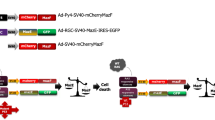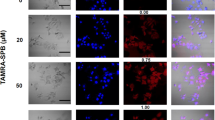Abstract
Bladder cancer is the most common cancer in the urological tract. Here, we investigated the molecular pathways involved in the apoptosis of rodent bladder cancer, which was treated with Bifidobacterium infantis (BI)-mediated herpes simplex virus thymidine kinase (HSV-TK)/ganciclovir (GCV) suicide gene therapy. We engineered the BI-TK system, which consists of BI with the recombinant plasmid PGEX-1λT carrying HSV-TK (that is, TK) gene. Tumor-bearing rats were randomly divided into three groups and tail vein injected with normal saline (group A), BI/PGEX-1λT (group B) or BI-TK (group C), followed by intraperitoneal injection of GCV. The BI-TK/GCV system (group C) was shown to inhibit tumor growth and caused the apoptosis of tumor cells as assessed by in situ terminal transferase dUTP nick-end labeling assay. While varied extents of apoptosis were detected in tumor cells from all groups, tumor cells treated with BI-TK/GCV system (group C) exhibited the highest level of apoptosis (P<0.05), consistent with our previous studies. Furthermore, we found that the expression levels of Fas, FasL, Cyt-C and caspase-9 in tumor tissues derived from group C were significantly higher than the other two groups (P<0.001). Therefore, our results have demonstrated that the BI-TK/GCV therapy system exhibits a sustainable antitumor growth activity in the rodent model of bladder cancer. Mechanistically, both extrinsic and intrinsic apoptosis pathways are involved in the BI-TK/GCV antitumor functionality.
This is a preview of subscription content, access via your institution
Access options
Subscribe to this journal
Receive 12 print issues and online access
$259.00 per year
only $21.58 per issue
Buy this article
- Purchase on Springer Link
- Instant access to full article PDF
Prices may be subject to local taxes which are calculated during checkout





Similar content being viewed by others
References
Pan JG, Zhou X, Zeng GW, Han RF . Potent antitumour activity of the combination of HSV-TK and endostatin armed oncolytic adeno-associated virus for bladder cancer in vitro and in vivo. J Surg Oncol 2012; 105: 249–257.
Terao S, Shirakawa T, Goda K, Kamidono S, Fujisawa M, Gotoh A . Recombinant interleukin-2 enhanced the antitumor effect of ADV/RSV-HSV-tk/ACV therapy in a murine bladder cancer model. Anticancer Res 2005; 25: 2757–2760.
Bergelson JM, Cunningham JA, Droguett G, Kurt-Jones EA, Krithivas A, Hong JS et al. Isolation of a common receptor for Coxsackie B viruses and adenoviruses 2 and 5. Science 1997; 275: 1320–1323.
Argnani A, Leer RJ, van Luijk N, Pouwels PH . A convenient and reproducible method to genetically transform bacteria of the genus Bifidobacterium. Microbiology 1996; 142 (Pt 1): 109–114.
Kohwi Y, Imai K, Tamura Z, Hashimoto Y . Antitumor effect of Bifidobacterium infantis in mice. Gann 1978; 69: 613–618.
Tang W, He Y, Zhou S, Ma Y, Liu G . A novel Bifidobacterium infantis-mediated TK/GCV suicide gene therapy system exhibits antitumor activity in a rat model of bladder cancer. J Exp Clin Cancer Res 2009; 28: 155.
Fu GF, Li X, Hou YY, Fan YR, Liu WH, Xu GX . Bifidobacterium longum as an oral delivery system of endostatin for gene therapy on solid liver cancer. Cancer Gene Ther 2005; 12: 133–140.
Fujimori M, Amano J, Taniguchi S . The genus Bifidobacterium for cancer gene therapy. Curr Opin Drug Discov Devel 2002; 5: 200–203.
Sasaki T, Fujimori M, Hamaji Y, Hama Y, Ito K, Amano J et al. Genetically engineered Bifidobacterium longum for tumor-targeting enzyme-prodrug therapy of autochthonous mammary tumors in rats. Cancer Sci 2006; 97: 649–657.
Jenes A, Ruzsnavszky F, Telek A, Szigeti GP, Csernoch L . A possible role of the cholinergic and purinergic receptor interaction in the regulation of the rat urinary bladder function. J Muscle Res Cell Motil 2012; 32: 421–431.
Li CG, Li ML, Shu XH, Liu YJ, Wu WS . Antitumor effects of recombinant human interleukin-6 on mouse bladder carcinoma through Fas-mediated apoptosis. Cancer Chemother Pharmacol 2010; 66: 981–986.
Mizutani Y, Yoshida O, Bonavida B . Prognostic significance of soluble Fas in the serum of patients with bladder cancer. J Urol 1998; 160: 571–576.
Wolfe D, Mata M, Fink DJ . Targeted drug delivery to the peripheral nervous system using gene therapy. Neurosci Lett 2012; 527: 85–89.
Ruiz-Moyano S, Tao N, Underwood MA, Mills DA . Rapid discrimination of Bifidobacterium animalis subspecies by matrix-assisted laser desorption ionization-time of flight mass spectrometry. Food Microbiol 2012; 30: 432–437.
Wei YX, Zhang ZY, Liu C, Malakar PK, Guo XK . Safety assessment of Bifidobacterium longum JDM301 based on complete genome sequences. World J Gastroenterol 2012; 18: 479–488.
Vaupel PW . Oxygenation of solid tumors. In: Teicher BA, (ed). Drug Resistance in Oncology. Marcel Dekker New York pp 53–85 1993.
Zhu H, Li Z, Mao S, Ma B, Zhou S, Deng L et al. Antitumor effect of sFlt-1 gene therapy system mediated by Bifidobacterium infantis on Lewis lung cancer in mice. Cancer Gene Ther 2011; 18: 884–896.
Hu B, Kou L, Li C, Zhu LP, Fan YR, Wu ZW et al. Bifidobacterium longum as a delivery system of TRAIL and endostatin cooperates with chemotherapeutic drugs to inhibit hypoxic tumor growth. Cancer Gene Ther 2009; 16: 655–663.
Yazawa K, Fujimori M, Nakamura T, Sasaki T, Amano J, Kano Y et al. Bifidobacterium longum as a delivery system for gene therapy of chemically induced rat mammary tumors. Breast Cancer Res Treat 2001; 66: 165–170.
Shirakawa T . The current status of adenovirus-based cancer gene therapy. Mol Cells 2008; 25: 462–466.
Maura D, Debarbieux L . Bacteriophages as twenty-first century antibacterial tools for food and medicine. Appl Microbiol Biotechnol 2011; 90: 851–859.
Chen Y, Wang G, Kong D, Zhang Z, Yang K, Liu R et al. Double-targeted and double-enhanced suicide gene therapy mediated by generation 5 polyamidoamine dendrimers for prostate cancer. Mol Carcinog 2011.
Alieva M, Bago JR, Aguilar E, Soler-Botija C, Vila OF, Molet J et al. Glioblastoma therapy with cytotoxic mesenchymal stromal cells optimized by bioluminescence imaging of tumor and therapeutic cell response. PLoS One 2012; 7: e35148.
Beltinger C, Fulda S, Kammertoens T, Uckert W, Debatin KM . Mitochondrial amplification of death signals determines thymidine kinase/ganciclovir-triggered activation of apoptosis. Cancer Res 2000; 60: 3212–3217.
Bai S, Du L, Liu W, Whittle IR, He L . Tentative novel mechanism of the bystander effect in glioma gene therapy with HSV-TK/GCV system. Biochem Biophys Res Commun 1999; 259: 455–459.
Hamel W, Magnelli L, Chiarugi VP, Israel MA . Herpes simplex virus thymidine kinase/ganciclovir-mediated apoptotic death of bystander cells. Cancer Res 1996; 56: 2697–2702.
Portsmouth D, Hlavaty J, Renner M . Suicide genes for cancer therapy. Mol Aspects Med 2007; 28: 4–41.
Haynes P, Lambert TR, Mitchell ID . Comparative in-vivo genotoxicity of antiviral nucleoside analogues; penciclovir, acyclovir, ganciclovir and the xanthine analogue, caffeine, in the mouse bone marrow micronucleus assay. Mutat Res 1996; 369: 65–74.
Nicholas TW, Read SB, Burrows FJ, Kruse CA . Suicide gene therapy with herpes simplex virus thymidine kinase and ganciclovir is enhanced with connexins to improve gap junctions and bystander effects. Histol Histopathol 2003; 18: 495–507.
Denning C, Pitts JD . Bystander effects of different enzyme-prodrug systems for cancer gene therapy depend on different pathways for intercellular transfer of toxic metabolites, a factor that will govern clinical choice of appropriate regimes. Hum Gene Ther 1997; 8: 1825–1835.
Acknowledgements
This work was supported in part by the research grant from the Natural Scientific Foundation of China (No. 81072087/H1619).
Author information
Authors and Affiliations
Corresponding author
Ethics declarations
Competing interests
The authors declare no conflict of interest.
Rights and permissions
About this article
Cite this article
Yin, X., Yu, B., Tang, Z. et al. Bifidobacterium infantis-mediated HSV-TK/GCV suicide gene therapy induces both extrinsic and intrinsic apoptosis in a rat model of bladder cancer. Cancer Gene Ther 20, 77–81 (2013). https://doi.org/10.1038/cgt.2012.86
Received:
Revised:
Accepted:
Published:
Issue Date:
DOI: https://doi.org/10.1038/cgt.2012.86
Keywords
This article is cited by
-
Bifidobacteria in disease: from head to toe
Folia Microbiologica (2023)
-
Bifidobacterium-derived membrane vesicles inhibit triple-negative breast cancer growth by inducing tumor cell apoptosis
Molecular Biology Reports (2023)
-
Recent trends and advances in microbe-based drug delivery systems
DARU Journal of Pharmaceutical Sciences (2019)
-
Combination of MPPa-PDT and HSV1-TK/GCV gene therapy on prostate cancer
Lasers in Medical Science (2018)



